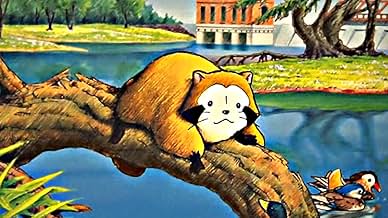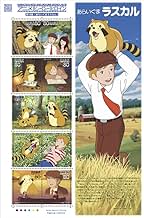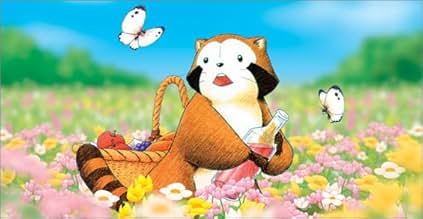An eleven year boy, Sterling North and his friend live in Wisconsin and hear a gunshot, the mother of a raccoon was shot and Sterling takes the baby Racoon home and heals it, naming him Rasc... Read allAn eleven year boy, Sterling North and his friend live in Wisconsin and hear a gunshot, the mother of a raccoon was shot and Sterling takes the baby Racoon home and heals it, naming him Rascal.An eleven year boy, Sterling North and his friend live in Wisconsin and hear a gunshot, the mother of a raccoon was shot and Sterling takes the baby Racoon home and heals it, naming him Rascal.
Browse episodes
Storyline
Did you know
- TriviaThe series was so well loved by children that many asked for raccoon pets from America. However, so many arrived and reproduced that they were eventually outlawed.
- ConnectionsFeatured in The Nature of Things: Raccoon Nation (2011)
- SoundtracksRokku Ribâ e
Lyrics by Eriko Kishida
Music by Takeo Watanabe
Arranged by Yûshi Matsuyama
Performed by Kumiko Ôsugi
Featured review
"Rascal the Racoon" was the 1977 entry in Japan's long-running World Masterpiece Theater, a series of animated adaptations of western literary works. It was based on Sterling North's "Rascal: A Memoir of a Better Era," an account published in 1964 of the author's childhood in Wisconsin and his relationship with a raccoon he'd rescued when it was a baby and raised as a pet. The book had been previously made into a live-action film by the Walt Disney Studio in 1969 and starred Steve Forrest and Billy Mumy.
For this review, I watched a 92-minute compilation of key sequences from the series, edited into a two-part TV special. It was in Japanese with no subtitles. The dialogue scenes were often a problem to follow, especially when they ended with the characters crying, but there are lots of scenes with Rascal, the raccoon, and Sterling, his pre-adolescent owner, and their antics together. We see Sterling rescue Rascal after its mother is killed by a hunter and watch as he nurtures Rascal and gets him acclimated to life in a rural household in Wisconsin in the 1910s. Sterling's mother dies not long after Rascal has entered the household and Rascal's affectionate attention helps him get through his grief. When Rascal sneaks away at night to raid a nearby cornfield, it arouses the ire of the local farmers and Sterling and his father have to build a pen around the tree where Rascal sleeps and keep him caged, much to Rascal's dismay. Eventually, Rascal responds to the call of the wild when a female raccoon begins to poke around his pen and Sterling has to make a tough decision.
There is one long suspenseful sequence early on where Sterling and his father try to return Rascal to the wild, thinking it's in his best interest. After some hesitation, Rascal has other ideas and his plaintive cries, as Sterling and his father paddle away in their canoe, are heartbreaking. What's remarkable about this scene is the quality of the voice work by the actress playing Rascal (Masako Nozawa, better known for playing Goku on "Dragon Ball") as the animal squeals and pleads for Sterling to come back. Throughout the series, in fact, the use of animal and other natural sounds is extremely well done, evoking a sense of place as well as any animated depiction of nature (including MY NEIGHBOR TOTORO).
While the human character design is fairly simple (as was the style on World Masterpiece Theater), the background designs are rich in detail, particularly when the characters venture into the forest and paddle their canoe upriver. The animation of Rascal is quite expressive as he climbs, nudges Sterling, and eats all sorts of foods, actions enhanced by Ms. Nozawa's voice work, all of which make Rascal the liveliest character in the series, almost to the point of Disney-style anthropomorphism at times. In the opening and closing credits sequences, we see all kinds of distinctly un-raccoon-like mischief performed by Rascal, including dipping his paw in an ink bottle and then applying his paw print to each page of a book, turning the pages with his other paw. His little claws turn out to be quite nimble in scenes like this and he eats more than his share of snacks, gripping a sandwich in much the same way that Sterling does. At times, Rascal behaves more like a dog than a raccoon, particularly when he rides in Sterling's bike basket and sits up and looks out. Sterling and Rascal have a kind of easy rapport that looks forward to the camaraderie shared by Ash Ketchum and his electric rodent Pokémon, Pikachu, in the long-running anime series, "Pokémon." Pikachu even bears a slight resemblance to Rascal. I wouldn't be surprised if the creators of "Pokémon" admitted to fond childhood memories of seeing "Rascal" on TV.
This was the first World Masterpiece Theater series to be set in America, so perhaps the animators can be forgiven for one glaring error in their depiction of American road rules: in scenes involving cars they put the steering wheel on the right side of the dashboard, the way it is in Japanese cars, and not on the left as it is in American cars.
A number of World Masterpiece Theater series were dubbed in English and shown in some form in the U.S., including two others based on American novels, "Tom Sawyer" and "Little Women." As far as I can tell, "Rascal" was never dubbed into English, nor has it been shown in the U.S., even in subtitled form. The book is popular, still in print, and continues to be read by schoolchildren here. From what I've seen of the series, it looks like something that could be easily embraced by an anime-savvy American audience, particularly one raised on "Pokémon." Is it not too late to release it here? Numerous other classic anime series have been newly released in English on DVD in the last couple of years, including "Mysterious Cities of Gold," "The Little Prince," "Rose of Versailles," and "Princess Knight." Can "Rascal" be far behind?
For this review, I watched a 92-minute compilation of key sequences from the series, edited into a two-part TV special. It was in Japanese with no subtitles. The dialogue scenes were often a problem to follow, especially when they ended with the characters crying, but there are lots of scenes with Rascal, the raccoon, and Sterling, his pre-adolescent owner, and their antics together. We see Sterling rescue Rascal after its mother is killed by a hunter and watch as he nurtures Rascal and gets him acclimated to life in a rural household in Wisconsin in the 1910s. Sterling's mother dies not long after Rascal has entered the household and Rascal's affectionate attention helps him get through his grief. When Rascal sneaks away at night to raid a nearby cornfield, it arouses the ire of the local farmers and Sterling and his father have to build a pen around the tree where Rascal sleeps and keep him caged, much to Rascal's dismay. Eventually, Rascal responds to the call of the wild when a female raccoon begins to poke around his pen and Sterling has to make a tough decision.
There is one long suspenseful sequence early on where Sterling and his father try to return Rascal to the wild, thinking it's in his best interest. After some hesitation, Rascal has other ideas and his plaintive cries, as Sterling and his father paddle away in their canoe, are heartbreaking. What's remarkable about this scene is the quality of the voice work by the actress playing Rascal (Masako Nozawa, better known for playing Goku on "Dragon Ball") as the animal squeals and pleads for Sterling to come back. Throughout the series, in fact, the use of animal and other natural sounds is extremely well done, evoking a sense of place as well as any animated depiction of nature (including MY NEIGHBOR TOTORO).
While the human character design is fairly simple (as was the style on World Masterpiece Theater), the background designs are rich in detail, particularly when the characters venture into the forest and paddle their canoe upriver. The animation of Rascal is quite expressive as he climbs, nudges Sterling, and eats all sorts of foods, actions enhanced by Ms. Nozawa's voice work, all of which make Rascal the liveliest character in the series, almost to the point of Disney-style anthropomorphism at times. In the opening and closing credits sequences, we see all kinds of distinctly un-raccoon-like mischief performed by Rascal, including dipping his paw in an ink bottle and then applying his paw print to each page of a book, turning the pages with his other paw. His little claws turn out to be quite nimble in scenes like this and he eats more than his share of snacks, gripping a sandwich in much the same way that Sterling does. At times, Rascal behaves more like a dog than a raccoon, particularly when he rides in Sterling's bike basket and sits up and looks out. Sterling and Rascal have a kind of easy rapport that looks forward to the camaraderie shared by Ash Ketchum and his electric rodent Pokémon, Pikachu, in the long-running anime series, "Pokémon." Pikachu even bears a slight resemblance to Rascal. I wouldn't be surprised if the creators of "Pokémon" admitted to fond childhood memories of seeing "Rascal" on TV.
This was the first World Masterpiece Theater series to be set in America, so perhaps the animators can be forgiven for one glaring error in their depiction of American road rules: in scenes involving cars they put the steering wheel on the right side of the dashboard, the way it is in Japanese cars, and not on the left as it is in American cars.
A number of World Masterpiece Theater series were dubbed in English and shown in some form in the U.S., including two others based on American novels, "Tom Sawyer" and "Little Women." As far as I can tell, "Rascal" was never dubbed into English, nor has it been shown in the U.S., even in subtitled form. The book is popular, still in print, and continues to be read by schoolchildren here. From what I've seen of the series, it looks like something that could be easily embraced by an anime-savvy American audience, particularly one raised on "Pokémon." Is it not too late to release it here? Numerous other classic anime series have been newly released in English on DVD in the last couple of years, including "Mysterious Cities of Gold," "The Little Prince," "Rose of Versailles," and "Princess Knight." Can "Rascal" be far behind?
- BrianDanaCamp
- Aug 5, 2013
- Permalink
Details
- Release date
- Country of origin
- Language
- Also known as
- Raccoon Rascal
- Production company
- See more company credits at IMDbPro
Contribute to this page
Suggest an edit or add missing content








